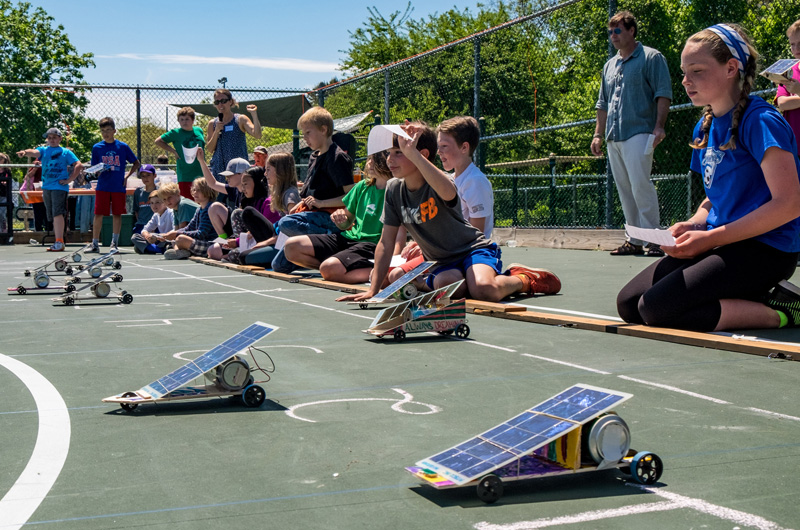Though they may be unlicensed, around 200 fifth and sixth graders spent Thursday afternoon racing cars behind the Edgartown School. The cars were small, sleek and solar — very au courant. The track? The court next to the playground.
According to Kara Gelinas, organizer of the solar car races and teacher at the Edgartown School, students spent the past few weeks preparing for the annual competition. In class they learn about energy transfer, gears and torque. Then they design and build cars for the big day.
Prior to the races, the students and their cars were assessed by volunteers from Cape Light Compact. The organization supports the event with materials and race day volunteers as part of their education outreach program.
The kids answered questions about how their cars work, why they made their engineering and design choices and the challenges they faced in the process. Prizes were awarded for technical merit, design, and knowledge.
“It is more complicated than you would think. Like you think you put up a panel and the sun comes in. But it has to do with small particles, like photons and electrons and atoms,” Sam Zack said. His partner Oisin McVey launched into a detailed explanation of a p–n junction. Together Sam and Oisin won the knowledge category of the competition for the up-Island schools.
The cars competed in two heats of racing, with the top three finishers from the first rounds facing off in the final heat.
Axel Abrams and Yossi Monahan took home first in the up-Island competition with their car, Skirt Skirt.
The aptly named Axel said: “It was very fun making it.” His partner Yossi interjected, “It was pretty hard, though.”
Axel concurred. “Yeah, we had to keep changing ideas.”
Doug Brush, fifth grade science teacher in Oak Bluffs said, “It’s a lesson in electricity, engineering, and sustainable energy, but also a lesson in frustration and perseverance.”
The frustrations on the big day were many. The races had their share of mishaps. The cars have one setting: on. They don’t have any mode for steering. To stay on course, they are attached to fishing line by a paper clip secured to the bottom of the chassis. A number of cars came unclipped from the line, veering wildly off track. There were many false starts.
And those were the relatively lucky failures — some cars didn’t move at all. Molly Sylvia and Ali Dyke, fifth graders at the Oak Bluffs School, explained that the cars are very delicate, and even the slightest bump could set something off kilter and render the car stationary.
But all in all, the day was a good one. Ms. Gelinas especially appreciated the break in the seemingly ceaseless dismal weather. “They’re strictly solar powered. If we have bad weather, then we have to go to battery packs, which is a real bummer, which is why this is amazing. It was supposed to be raining,” she said, looking up at a cloudless sky.








Comments
Comment policy »